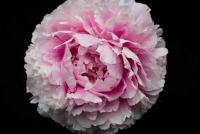A flower similar to a daisy with a blue heart. Chamomile garden large perennial: how to choose and grow in the garden.
Read: 97
There are many different colors, so similar to the well-known daisies, but do not confuse them
Daisies are flowers that almost everyone loves. But many daisies call plants that are only very similar to them, but in fact are separate species.
These flowers look great in flowerbeds, decorate any lawn in parks or squares, can be planted separately, or in combination with other flowers.
About how these plants look, so similar to everyone's favorite chamomile, let's talk below.
Anacyclus (anatsilus)
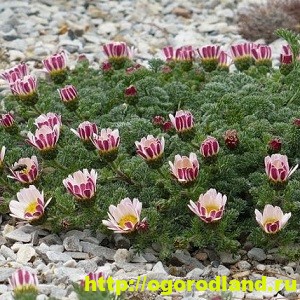
Anacyclus Chamomile for rock garden, rock arias, etc.
This plant is so similar to chamomile that they are confused not only by beginner gardeners, but also by many who are engaged in the cultivation of flowers for more than one year. There are more than 8 subspecies of this flower, they can be annuals and perennials. Anacilus usually blooms in the last days of May and blooms until the first decade of August, so it is readily used for planting parks, flower gardens and lawns in squares.
Anatsiklyus belongs to the Astrov family and has one feature: with the onset of the evening, the flowers close, and with the first rays of the sun begin to open again. The petals of these species from above are white, and from the bottom they have a pink tint, which is what distinguishes them from daisies. Anaciluses - low in size, creeping along the ground, pedicels - strong, flowers in diameter can be 4 - 4.5 cm.
Doronicum (kozulnik)
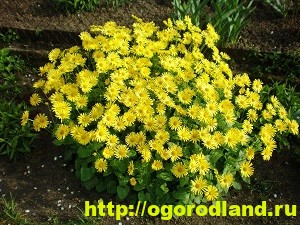
Doronicum
Doronikum is one of those flowers that starts flowering in early May and blooms until mid-June. However, often the goat begins to bloom again by the end of July and fade away only at the end of September.
His main positive qualities - unpretentiousness and resistance to spring weather changes. In total, there are over 37 species of doronicum, but no more than a dozen of its varieties are popular. This flower can grow from 0.5 to 1 m - depending on the variety. The flowers are quite large - 9 - 11 cm in diameter.
Cut flowers can stand in a vase for 10 - 14 days without fading. It should be remembered that the aerial parts of the plant are poisonous. If these flowers are planted under the trees, then they will grow there badly and bloom - fruit trees strongly oppress kozulnik.
Nivyanik
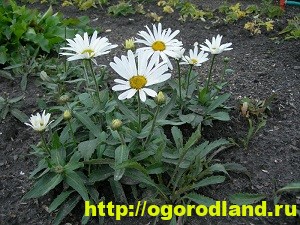
This plant is the meadow chamomile that is found everywhere - in the meadow and in the ravines, on the edge of the forest and on the side of the road. The most common form of it is called Nivyanik. There are many kinds of it - there are terry, with needle-like petals, with large or small flowers. In different regions of our country, the plant is grown as a perennial, begins to bloom in early June, and ends flowering in late October. Nivyanik unpretentious to the soil on which it grows, and to the place where it grows.
Calendula (marigold)
Calendula is the original pale yellow or rich yellow flowers with a lighter middle (sometimes dark). It has a peculiar aroma, small size of flowers - about 5 cm in diameter. The other name of the plant is marigold, so they were nicknamed for the similarity of the seeds of the plant with human nails. Most often on garden plots the medicinal variety of calendula is grown, but later the marigolds were planted and how ornamental plant. Calendula multiplies mainly self-sowing.
Daisy
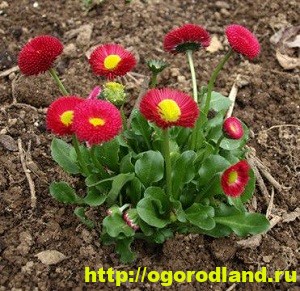
Daisy
Daisy is another flower that is often mistaken for small daisies. Especially similar varieties of daisies with white petals and yellow center. However, the petals of this flower can be of different colors: red, lilac, bright yellow and some others.
Flower is no different large sizes, the first buds bloom in May, and the daisy continues to bloom almost to frost.
Although daisies look delicate and fragile, they are unpretentious, hardy and can grow almost everywhere. It is this flower that enters
the composition of the floral mixture Moorish lawn.
Pyrethrum

Pyrethrum
Pyrethrum is unusually similar to chamomile in the form of flowers and foliage. It is distinguished only by the color of the petals - pale pink.
This plant is a perennial, and once planted in a flower garden, you can rejoice in its flowering from year to year. Moreover, its flowering begins at the end of spring and lasts almost all summer.
Pyrethrum is unpretentious, it grows almost everywhere, but does not like a lot of moisture in the soil.
Arktotis
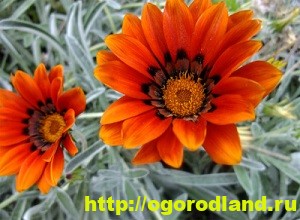
Arktotis
The second name of arktotis is the bear's ear. There are two types of plants - tall (about 1.10 m in height) and short (0.20 cm in height).
Petal ear bears can be white, red, yellow, cream, pink. The color of the arktotis says that this is a hybrid view.
This flower loves sunlight, the petals of its flowers open at sunrise and close again at sunset. Arktotis resistant to drought, does not require a large amount of moisture, resistant to cold snaps.
Gatsania

This flower is amazing variety of color of its petals. They can be one-color and two-color, often one shade smoothly into another, and the colors occur from lemon to red and lilac.
There are more than 35 varieties of gazania, and they are all frost-resistant, like sunlight, are resistant to heat and the dry season.
It is used to decorate lawns and borders, can be grown in pots and boxes. It grows both with other flowers, and alone.
Gerbera

In terms of their structure, the gerbera is more similar to the chamomile in terms of its flower structure and size. Distinguishes gerbera variegated petals. It is pink, cherry, scarlet, orange, cream, bright yellow, lilac.
There are many different types of gerberas, as well as shades, so florists willingly use it to compose a variety of compositions. In addition, it retains its original freshness for a very long time after cutting (up to 2
weeks).
There are terry types of gerberas, and you can grow them in the open field, at home, on the balcony. They bloom in early July and continue to bloom almost to the very cold.
Venide
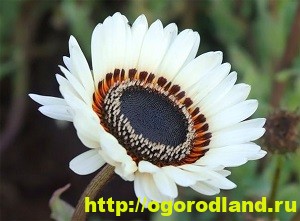
Venide
This is a very original flower, very similar to a daisy. Large baskets with a diameter of about 9 to 12 cm have a white or yellow-orange color of the petals, at the base of which are purple strokes with a black tint, and the middle of the flower consists of small black tubular flowers.
These are very original annuals that will perfectly complement any flowerbed or lawn.
Kosmeya
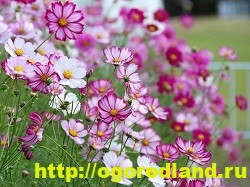
These flowers most often multiply by self-sowing. It is enough to plant these unpretentious flowers in one place, as in a couple of seasons the kosmeya will delight with its flowering throughout the garden plot.
Decorative vegetative mass and beautiful flowers perfectly complement each other. These flowers can be planted anywhere in the garden or park, and they will actively grow and bloom.
There are more than 20 types of cosme, and the color of their petals is white, red, and gently purple.
Ursinia
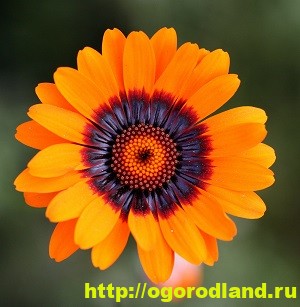
This is a little-known variety of plants, very similar to chamomile. The most popular is the variety Ursinia umbilous (dill) - small bushes up to 45 cm high, which actively grow in different directions.
The flowers are orange with a dark heart and red stains around the center.
The second name - dill - Ursinia received for leaves that are similar in shape to not dissected thin dill leaves. It blooms all summer until early September. And the flowers do not close even in cloudy or rainy weather. It grows best and blooms in sunny areas with sandy soil.
Conclusion
There are many different colors, so similar to the well-known daisies, but do not confuse them with each other.
Fine( 8 ) Poorly( 1 )
Garden chamomile - perennial flowers that belong to the asteraceae. Due to their beauty, durability and unpretentiousness in the care of these plants are often an excellent basis for the creation of garden design. In their favor, and the fact that the cultivation can be made even from ordinary seeds. It is much easier and cheaper than bulbous and sapling perennials.
Short story
Chamomile itself is a wildflower that appeared in gardens in decorative form due to its tenderness, beauty and touchingness. In our country, the name of the plant was used in the eighteenth century. Translated from Polish, it means "Roman flower". On the territory of Russia, these plants were known long before that. Moreover, there was a legend that they grew up in places where the stars fell. In ancient Rome, the flower was very revered due to its medicinal characteristics, and in ancient Egypt it was considered one of the main symbols associated with Ra (the god of the sun). Modern garden perennials are nothing but the result of the work of breeders.
general description
The plant prefers a large amount of sun and heat. Along with this, in the shadows it will also develop. The land part dies at the end of autumn, however, after the warm period begins, the growth resumes. Chamomiles can have different color and shape of a basket of inflorescences. The range of colors of the marginal flat petals is quite diverse: they are white, lilac, yellow, red, pink, brown and others. As for the middle, it is usually yellow or red-brown. The flowering period in most species lasts from 40 to 60 days. 
Growing conditions
Most of the varieties of these colors require sunny color for at least 3-5 hours a day. The most favorable for them are soil types, the acidity of which is close to neutral. Whatever it was, on fertile soils, they will develop faster, and bloom more abundant. Garden chamomiles are among the moisture-loving plants, so they need regular watering. This is especially true of dry periods. At the same time, it is impossible not to emphasize that stagnant moisture often causes the death of flowers, so the soil on which water stagnation is observed must be drained after long rains or spring thaw.
Breeding
The simplest and most common method of reproduction of plants are seeds. Their sowing directly into the ground is usually carried out in May. After that they are covered with film. The first shoots appear after three weeks. An important nuance in this case is that the seeds must first be held in the refrigerator or in the snow for about four weeks. This will allow them to harden. Sowing on seedlings is usually produced at the end of March. As soon as two true leaves appear on the plants, they should be unpacked in separate containers and planted only when the threat of frost has passed.
Flowers grow fairly quickly, so every four to five years a chamomile garden is transplanted. It is best to implement it in spring or autumn, after the end of the flowering period. It is necessary to divide a bush depending on quantity above ground shoots. This breeding method is also considered fairly simple. It should be noted that if garden chamomiles are at the same place for more than five years, the probability of their death is rather high, therefore transplantation is obligatory. 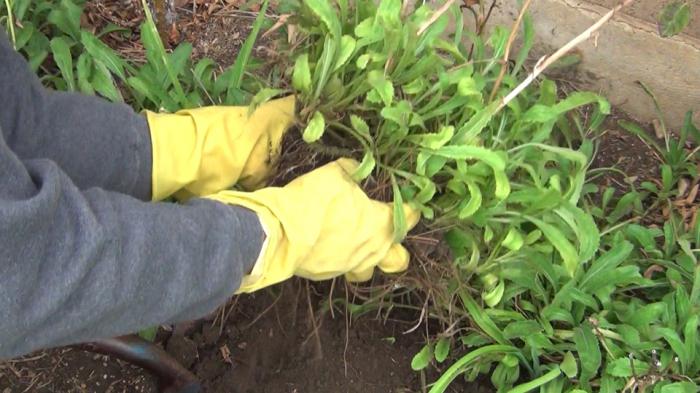
Some of the varieties are fairly well grafted. However, this method of reproduction is rather laborious, therefore it is used extremely rarely.
Varieties
In general, there is a huge number of varieties of these plants, differing in height, size of baskets and flowering time. The most common in the territory of our country are such varieties of chamomile garden as feverfew, nivyanik, small-scalestone, doronicum and pharmacy chamomile.
Pyrethrum
Another common name for this plant is Persian chamomile. It has red, pink or yellow petals, which, depending on the variety, are double or simple. The height of the flower is in the range from 0.5 to 1.5 meters. These garden chamomiles are best developed in sunny areas. As for the type of soil, the ideal option for them is a nourishing, well-drained soil. Every four years it is necessary to divide the plant. In dried form, it is often used to protect against moths. As practice shows, in the garden these flowers are very well combined with bells, yarrow, nivyanik and oriental poppy. 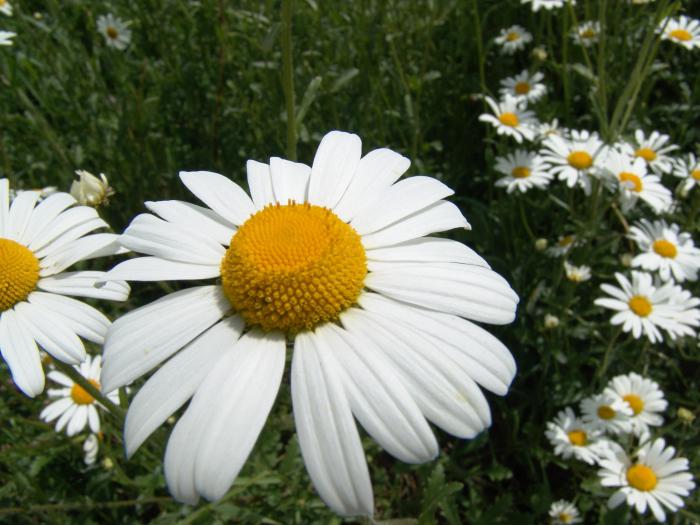
Nivyanik
This plant is also known as chamomile and large garden garden. In total, there are more than twenty of its varieties. Domestic gardeners, as a rule, grow three of them - ordinary, Kuril and the biggest cornfield. The flower has double, simple or semi-double petals and a yellow center. Like other varieties, the plant prefers places with a lot of light and is not too demanding on the soil. It should be divided once every three years. As for the care, these flowers require regular watering. Feeding is also quite good on the cornflower. Against the background of relatives, the large garden chamomile stands out for the largest size of its flowers.
Small-scale painter
The period of flowering in this variety begins in mid-June and lasts about one and a half months. Its representatives grow to a height of one meter. Flower petals are white, purple, blue or pink color. Like other types of daisies, small-littered areas with loose soil types are best suited to the small-scale sculptor.
Doronicum
This flower is a perennial early flowering plant. Its height, depending on the subspecies, ranges from 20 to 70 centimeters. To the soil, these flowers are undemanding and rapidly develop even in conditions of slight shading. Doronicum petals have a yellow color. As for the flowering period, it begins in May and ends in June. 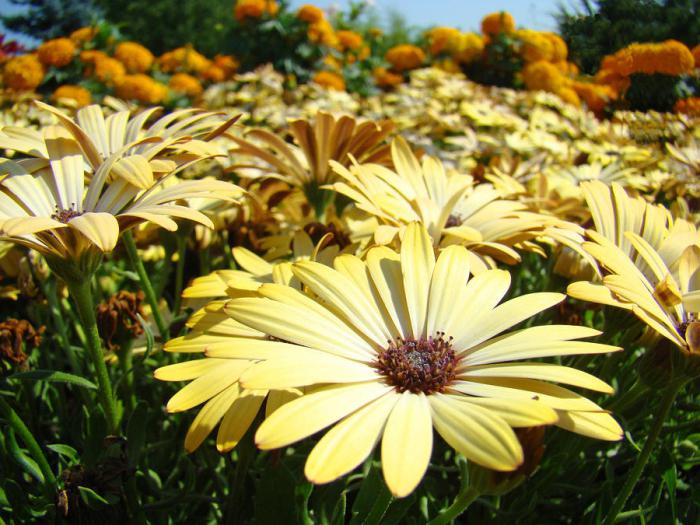
Pharmacy Chamomile
This variety has recently become one of the most popular with domestic gardeners. This is not surprising, since the medicinal properties of chamomile are known since ancient times. They are good antiseptics, so they can be used for the prevention and control of many diseases, as well as in cosmetology. These camomiles, among other things, have a very pleasant apple flavor. 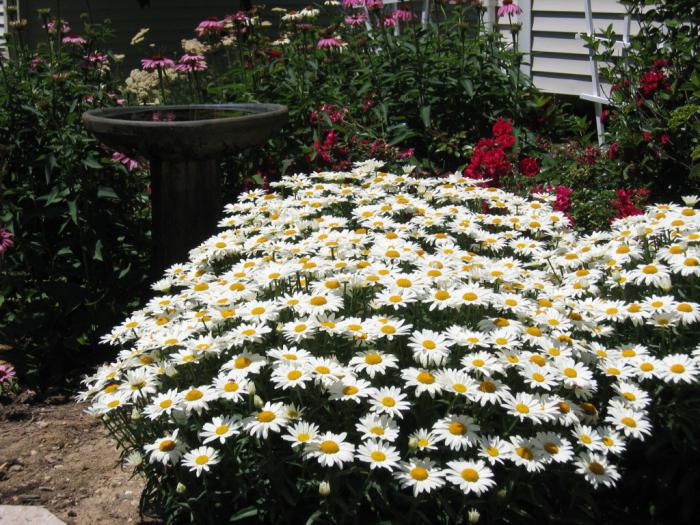
Daisies and diseases of camomiles
Like many other flowers, garden chamomile can be adversely affected by diseases and pests. If you do not provide proper care for her and do not carry out prophylaxis, she can die from diseases, the most common of which are rust, gray rot, powdery mildew and fusarium. The main thing that should be done to prevent them is to avoid excessive amounts of moisture in the soil. To do this, it is necessary to loosen and weed, and the ground part to process fungicides. In the event that at least one of the individuals of the plant is still seriously affected by the disease, it is recommended to remove it, which will prevent general infection. The worst enemies afflicted by chamomile garden are thrips, aphids, wireworms and star-winged fly. To combat them, flowers should be treated with special insecticides.
Chamomile garden - a modest beauty who is able to immodestly decorate any flower bed. This flower brings a romantic mood. For beginners, chamomile is a real find in terms of simplicity. Since ancient times, this sunny flower has a beautiful legend of its origin. People believed that daisy grows on the site of a fallen star.
Chamomile was originally a wild plant. It is worth seeing the chamomile field once in your life, and you will certainly want to transfer at least a part of such unforgettable beauty to your plot. The cultivated varieties of chamomile are no less beautiful. They bloom long enough due to numerous shoots, which allows you to enjoy the beauty of this lovely flower for a long time. Chamomile carries not only aesthetic value, but also practical. Experienced flower growers know that chamomile garden can be successfully applied in traditional medicine, cosmetology and even cooking. Various infusions, decoctions that have anti-inflammatory, wound-healing, antiseptic effects are made from this flower. Chamomile also has the famous “whitening” property, therefore it is included in creams, tonics, facial lotions, shampoos for blond hair, etc. Young stems and shoots of chamomile will be able to elegantly complement the summer salad or sauce. In the article we will try to highlight the most important aspects of growing chamomile garden, the secrets of caring for this plant and much more.
What does a garden daisy look like?
Chamomile is known to man since ancient times. In ancient Rome, this flower was associated with the God of the Sun, for which he received his second name - "solar flower". It was believed that chamomile grows where the Sun God passed. Translated from the Polish chamomile also translated as "Roman flower". Chamomile can not be overlooked in the garden or confused with another plant. It has the following special features:
- Consists in the family of aster perennials.
- It can reach a height of 30-100 cm.
- Smooth petals neatly arranged around the core.
- The flower can reach up to 15 cm in diameter.
- The leaves are smooth, two-leaved, beautiful green.
- It blooms all summer from June until September.
- The flower is quite unpretentious, can grow both in sunny terrain and in the shade.
- By autumn, the ground part of the plant dies, and grows in the spring again.
Popular varieties of chamomile garden
Of course, breeders have made a huge contribution to the variety of garden chamomile varieties that we can now observe. Flowers are distinguished by the height of the stem, the shape and arrangement of the petals, the duration of flowering, there are double and smooth varieties. The secret of a beautiful flower bed depends largely on what sort you choose. Therefore, it is simply necessary for a novice grower to know minimal information about the growth characteristics of a garden chamomile variety.
North Star
This snow-white beauty can be a real decoration of any site. The stem can reach a height of 60-70 cm. Prefers the sunny side, easily tolerates drought. It can be planted seedlings in the spring and autumn. But this daisy will bloom only in the second year.

Garden princess
This variety of garden chamomile has a lot of advantages. It grows in a compact form due to the huge number of side shoots that reach 35 cm in length. Another advantage is that the Garden Princess can be sown directly in open ground. The flowering period will delight any florist - from the beginning of summer to autumn frosts. Prefers an area protected from drafts with loose and airy soil.
Nivyanik
The largest garden chamomile - this is Nivyanik. It is often grown for commercial purposes, i.e. for sale on bouquets. Powerful and strong stems reach 80 cm in height. The brightly contoured yellow heart is surrounded by beautiful snow-white petals. Propagated by dividing the bush, which is best done 1 time in 3-4 years or seeds.
Silver princess
This variety of garden chamomile can be successfully used in group plantings. Flowers in a fully open state reach 10 cm in diameter, and the stem grows up to 30 cm. The snow-white smooth petals are located around the yellow middle in one row, giving the flower a cute and simple image.
Large-flowered Alaska
Large-flowered Alaska is a real giant among the garden daisies. Can grow up to 90 cm in height! The advantages of this variety are its drought tolerance, unpretentiousness and the possibility of planting closer to winter. On next year you will already admire lush bloom. Buds bloom up to 10 cm in diameter.
Winner
Another popular among gardeners garden chamomile variety - Winner variety. He, like Krupnotsvetkovaya Alaska, refers to the giants among the daisies. It reaches a height of 50 cm to 90 cm. The flowers are slightly smaller in diameter - 8-12 cm. It blooms the next year after planting and grows about 3-4 years.
How to grow chamomile in my area
If you have already seen the varieties of chamomile garden and made a choice for yourself, then it's time to explore the technology and methods of its cultivation. Chamomile can be grown in several ways. It cannot be said that one of them is easier, and some is more difficult. There are varieties that can be grown, for example, only in seedlings. And others can be sown with seeds directly into the open ground. So, if you do not want to mess with seedlings, then keep this fact in mind when choosing a variety. Regardless of which landing method you choose, stick to the following site selection criteria:
- give preference to flat soils;
- mostly all daisies love sunny places;
- before planting any soil, even the most fertile in your opinion, should be fertilized;
- to reduce the acidity of the soil, you can use hydrated soda or dolomite flour;
- consider the size of the future adult plant, leave enough space between the plants. So, it will be easier for you to fight weeds and all parts of the flower will get enough sunlight.
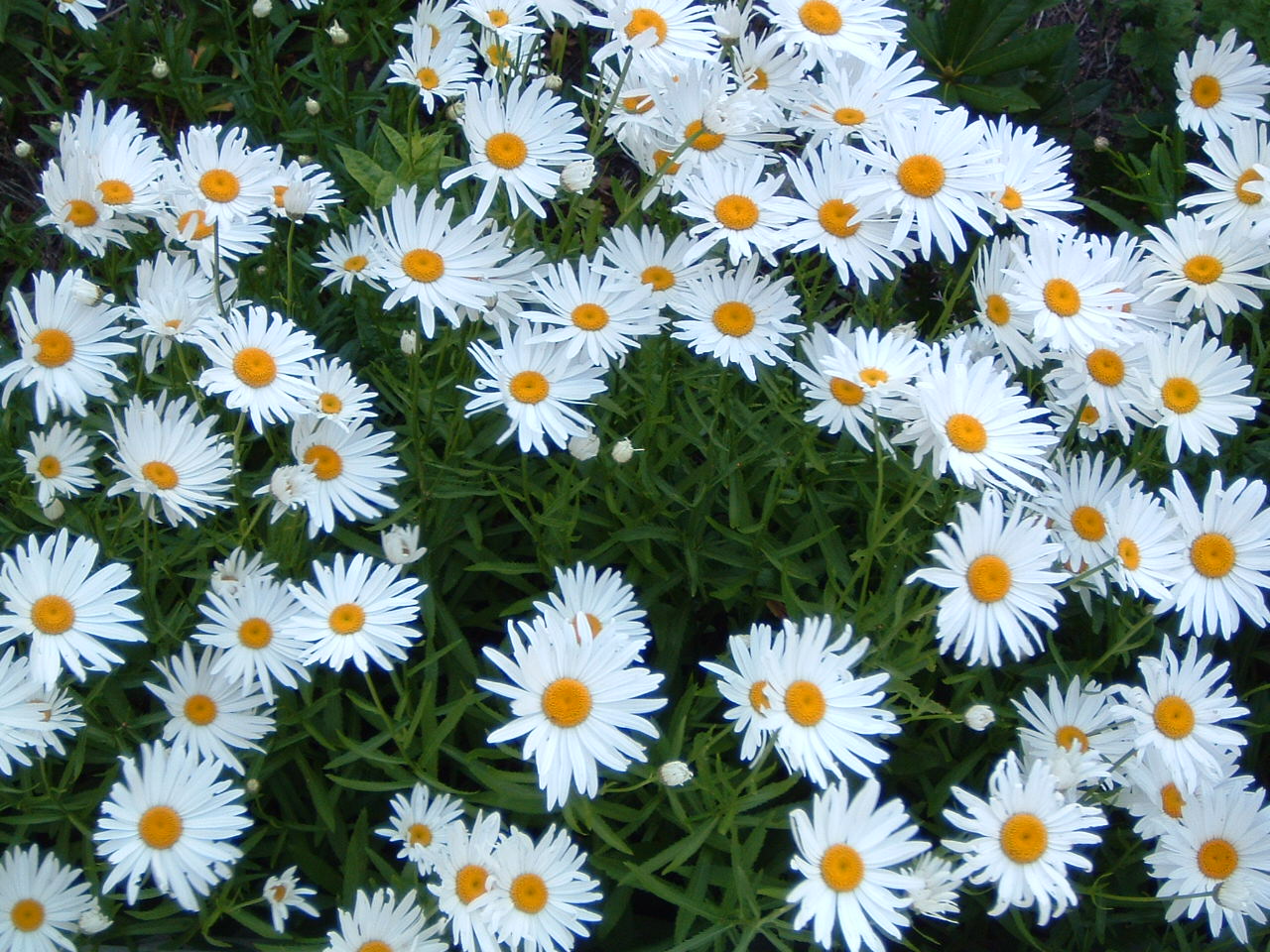
Method 1. Growing chamomile garden seedling method
The method of growing chamomile through seedlings is not much different from growing seeds. You will have to tinker a bit with plastic cups or similar containers.
- Prepare suitable containers in advance. If you choose large boxes, then you still have to swoop down the plants in smaller glasses or pots.
- At the bottom of the tank must be a good drainage. Daisies do not tolerate stagnant water.
- Seeds are very small. In order for them to germinate, it is not necessary to fall asleep with a thick layer of earth. It is enough only to slightly “sprinkle” with earth or leave it completely on the surface, slightly pressing it down. Sow the seeds, of course, need to pre-fertilized soil mixture and moist.
- Before the appearance of the first shoots, the chamomile should be sprayed from the pulveler and kept under a film in a warm and dark room.
- The first seedlings appear on the 10-14 day. After that, you need to remove the shelter and move them to a sunny place.

Method 2. Cultivation of garden chamomile seeds
Cultivation of chamomile seeds is a fairly simple way, which is especially to the liking of beginner gardeners. However, not all varieties of garden chamomile can grow in this way immediately in open ground. The features of this method are:
- Some varieties of garden chamomile can be sown even in autumn. But most still prefer spring. This is usually done at the end of May or the beginning of June, when the weather is warm enough. The site should be sunny and windless.
- The soil should be prepared, namely, fertilized with mineral fertilizers.
- Chamomile seeds are very small and difficult to separate when planting. Therefore, a thinning method is used when the plants grow up.
- Seeds are sprinkled with a thin layer of soil.
- If you are afraid of the threat of freezing, you can cover plantings with a film or other similar material.
- After the emergence of the first sprouts need regular watering.
- After 4-6 leaves have appeared, plants can be thinned out, leaving 2-3 pieces at one growth point. Between plants leave a distance of 30-40 cm.
- Further, the scheme of cultivation is the same as when sowing seeds in open ground. When the threat of frost has passed, around the end of May, plant 2-3 seedlings in one hole.
Method 3. Cultivation of garden chamomile by dividing the bush
The division of the bush - this is no less popular way of breeding chamomile on the site. This procedure is best done in the spring. You need to dig the bush as carefully as possible, without damaging a single escape. It is better not to use sharp gardening tools, but for the most part do it with bare hands. Depending on the size of the bush, it is divided into 2-3 parts. Holes for new bushes are dug in accordance with the size of the root system. The bottom of the planting pit is fertilized with mineral fertilizers and sprinkled on top of the ground. A new chamomile bush necessarily requires watering.
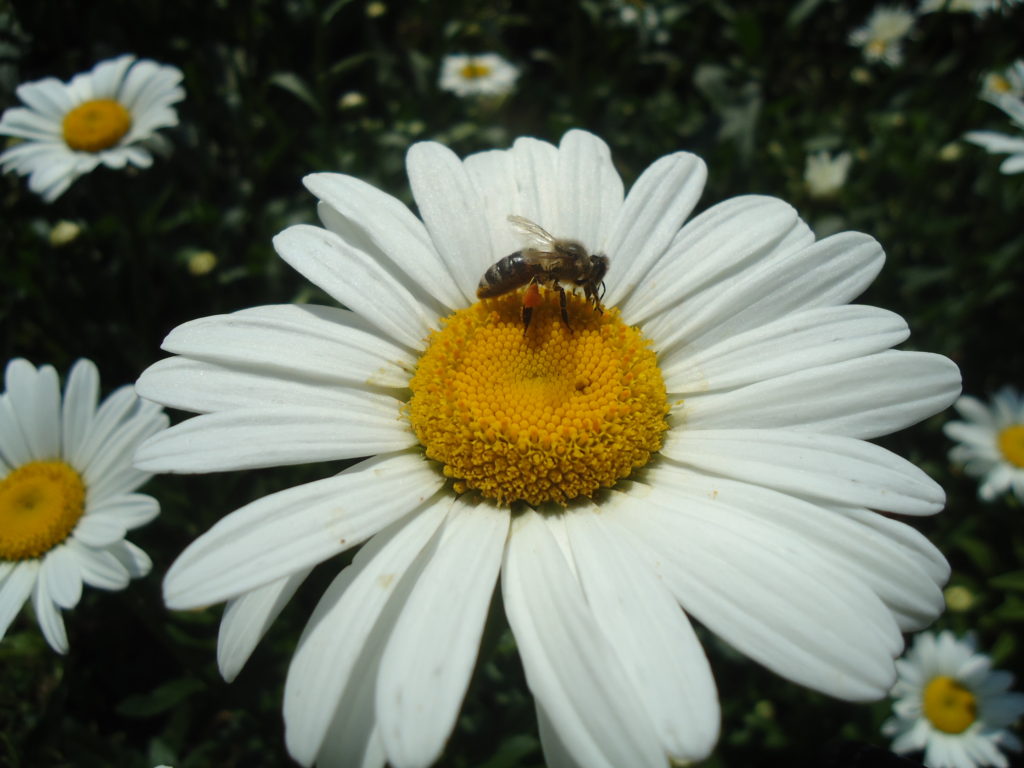
Secrets of caring for the "sun flower"
So, you successfully planted a beautiful chamomile in your plot. Although it is an unpretentious flower, it still requires elementary care to preserve the aesthetic appearance and health of the plant. What you need to know about the care of the "sun flower"?
- like any garden plant, chamomile requires watering. It should be regular and fairly plentiful. On hot days, you should especially carefully monitor the level of soil moisture. Some varieties of garden chamomile are drought tolerant, but the drying of the lower level of the soil should not be all the same;
- regular weeding. Weeds need to be harvested not only so that the flowerbed looks neat and well-groomed, but also for the health of the plant. After all, weeds can be carriers of various diseases and pests. In addition, the highly developed and powerful root system of some weeds can damage the chamomile bush;
- loosening the soil. Loosen the soil for good access of moisture and air to the roots;
- rejuvenation of the bush. Such a simple procedure should be carried out on average after 5 years of bush life. On the one hand, the bush is cut, and fertile soil is poured into the resulting hole. After 3 years, repeat the procedure in the same way, only on the other side of the bush;
- most garden daisies love sunbathing. Consider this fact when planting a plant, avoid neighbors who will create a permanent shadow on the flower;
- chamomile needs help getting ready for winter. Before the onset of frost you need to cut off the aerial part of the plant. Young bushes need to cover the fallen leaves, but adult plants themselves tolerate frosts;
- if you want to collect chamomile seeds, then this can be done. Wait until the flower is completely dry, cut it, let it dry in a cool and dark room. After that, you need to gently peel the seeds, sift them from possible debris, dry and collect in paper bags. Store such seed bags in a cool, ventilated and dark room.
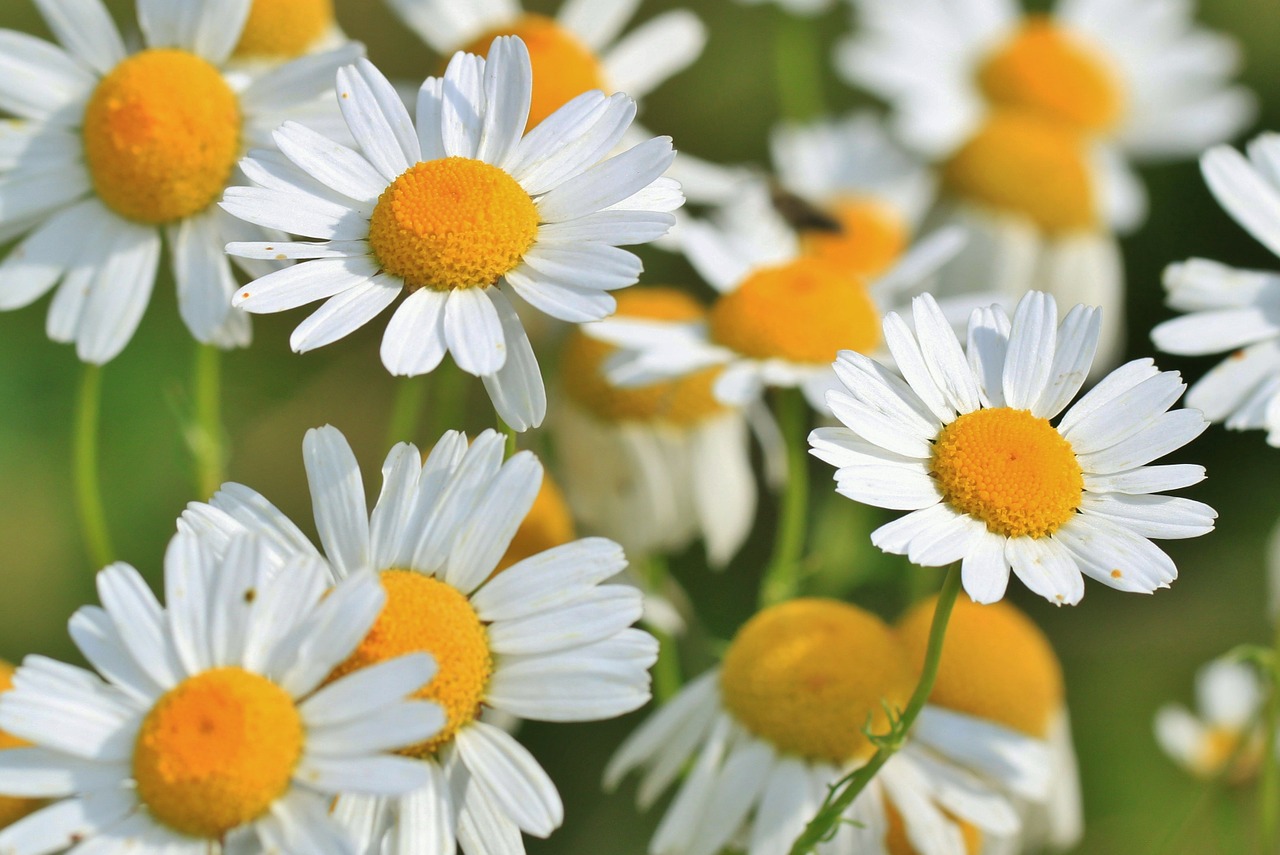
Do I need to feed chamomile garden
Of course, you can forget about feeding a flower and think that it is not so necessary. But then do not be surprised why on the neighbor's site the daisy looks richer and more effective compared to yours. Chamomile loves feeding and loves them:
- the very first top dressing occurs in the process of preparing the soil before planting chamomile garden. Rich organic compounds are suitable for this purpose. After making fertilizer, the root circle needs to be mulched;
- the second dressing is carried out in the middle of spring with ammonium nitrate. It is better to pre-water the soil before dressing, for good absorption of fertilizer. You will need about 20 grams of fertilizer per 1 square meter;
- in the period of tying the buds will not interfere with dressing with urea. But she needs only faded plants;
- in order to prevent excessive soil oxidation with mineral fertilizers, nitrogen-containing feedings should be used periodically. For example, mullein, bird droppings.
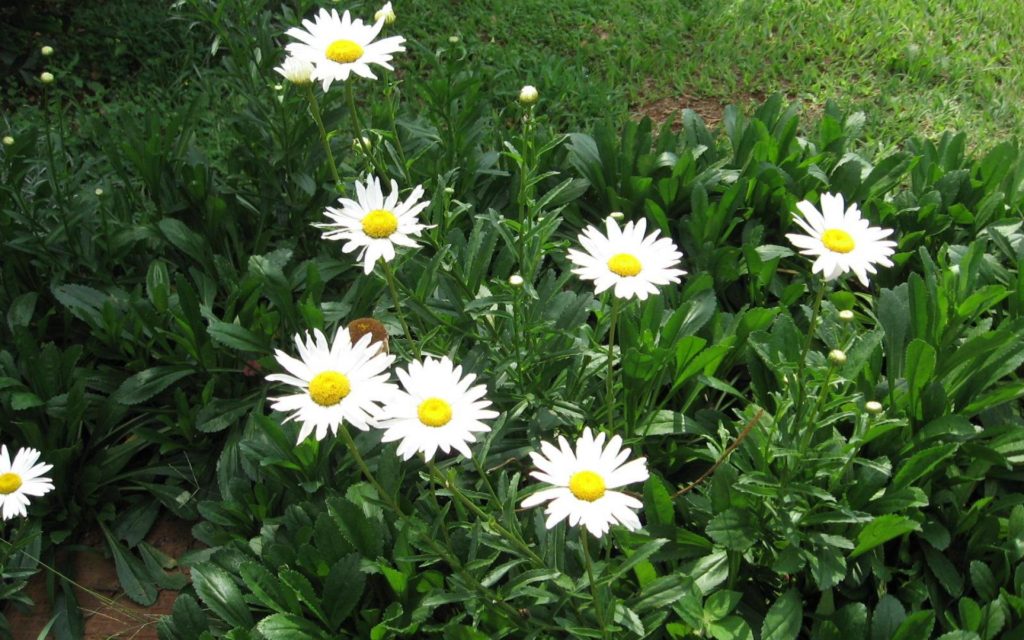
Possible pests and diseases of chamomile
Florists are always upset when their pets in a flowerbed are invaded by pests or diseases. Violation of planting technology, soil contaminated with pests, neglect of weeding or watering can all have a negative impact on the health of chamomile. What to do to the snow-white beauty-daisy pleased with their appearance? To do this, you must comply with all the requirements for care, although they are small. In order not to miss a possible infection of a flower, you must certainly know the enemy in the face. Among the most common diseases of chamomile garden can be identified:
- rust. Rust can be identified immediately if you notice a red spot on the upper side of the sheet. The spores of the fungus are on the back of the leaf;
- gray rot This disease progresses much faster with high humidity. Brown spots on parts of chamomile are becoming more and more, gradually becoming covered with gray tint;
- powdery mildew. The disease can be recognized by the appearance white plaque on the aerial parts of the plant. Gradually, affected parts of chamomile become brown in color;
- fusarium This fungal disease begins to affect the roots and root neck. They begin to rot, the plant loses its tone, it becomes brown, the stem becomes thinner and the plant dies.
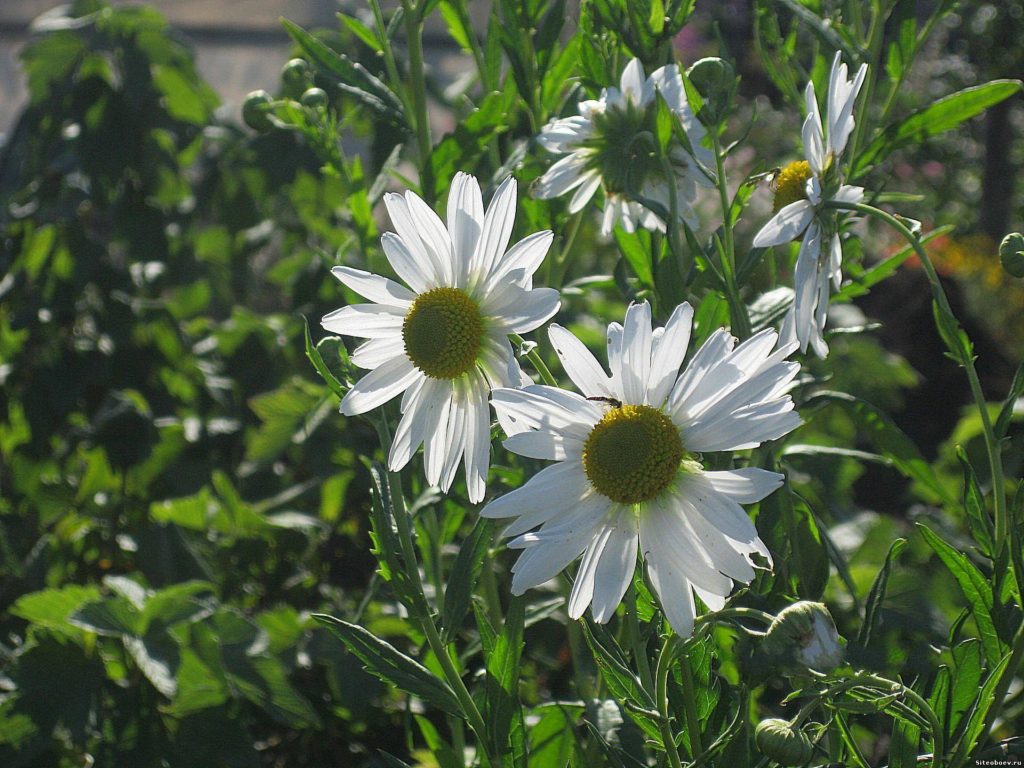
The plant should be regularly inspected to prevent oversupply and stagnant moisture in the soil. For prevention, you can use fungicides that process the above-ground part of chamomile. If most of the bush is already affected, then it is better to remove it to prevent infection of neighboring plants.
Among the pests that love to feast on chamomile garden are the following:
- star-winged fly This is the very pest that can live on chamomile, if we neglect weeding. The larvae settle at the base of the flowers, gradually capturing the entire plant;
- aphid and thrips. These sucking pests are very dangerous, because literally pulling all the vital sap of the plant. Whitish spots, stripes appear on the leaves, the flowers become deformed, the plant gradually loses its tone and dies;
- wireworm. These are the larvae that feed on chamomile roots. They live in the soil up to 4 years.
Photo of chamomile garden in landscape design


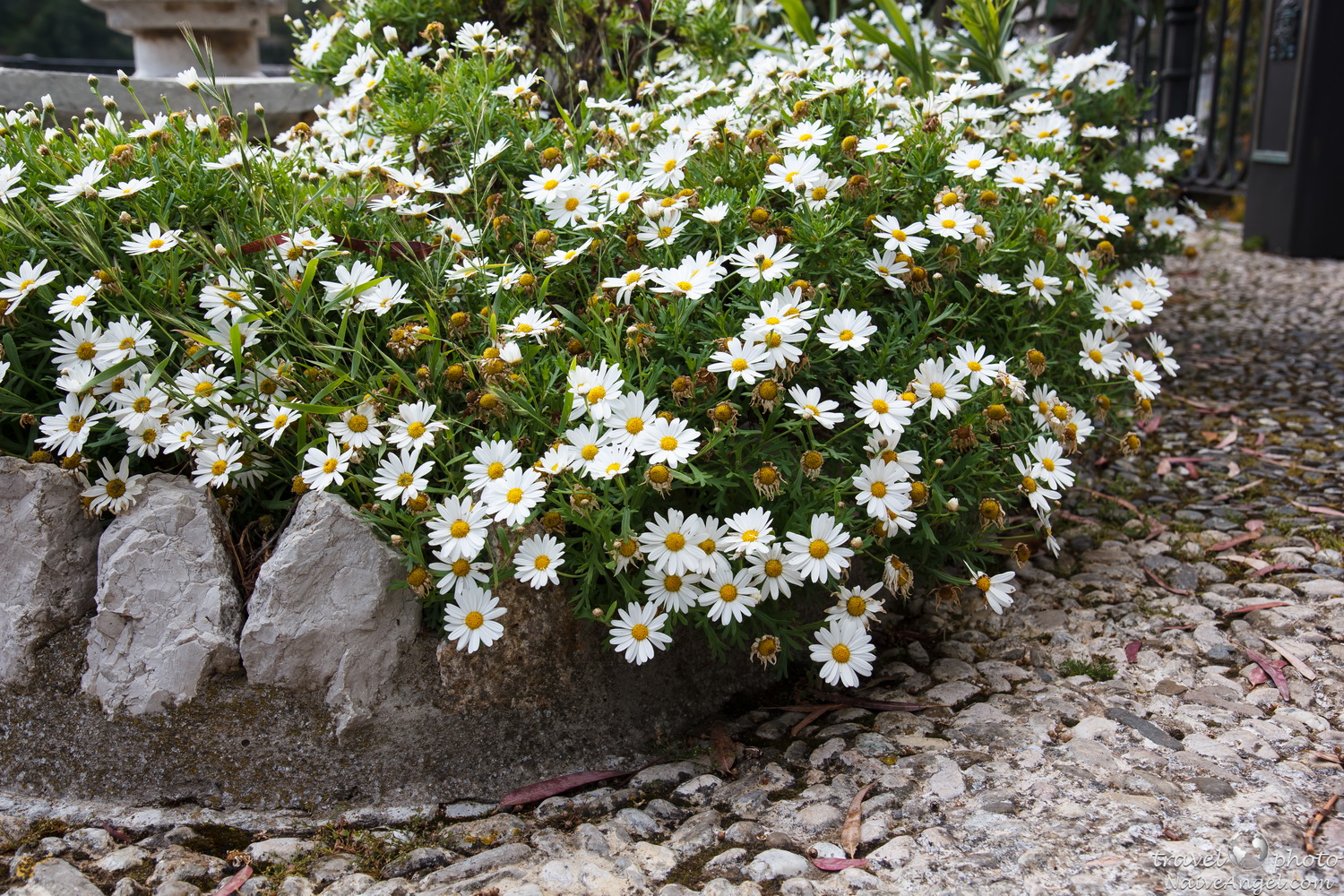
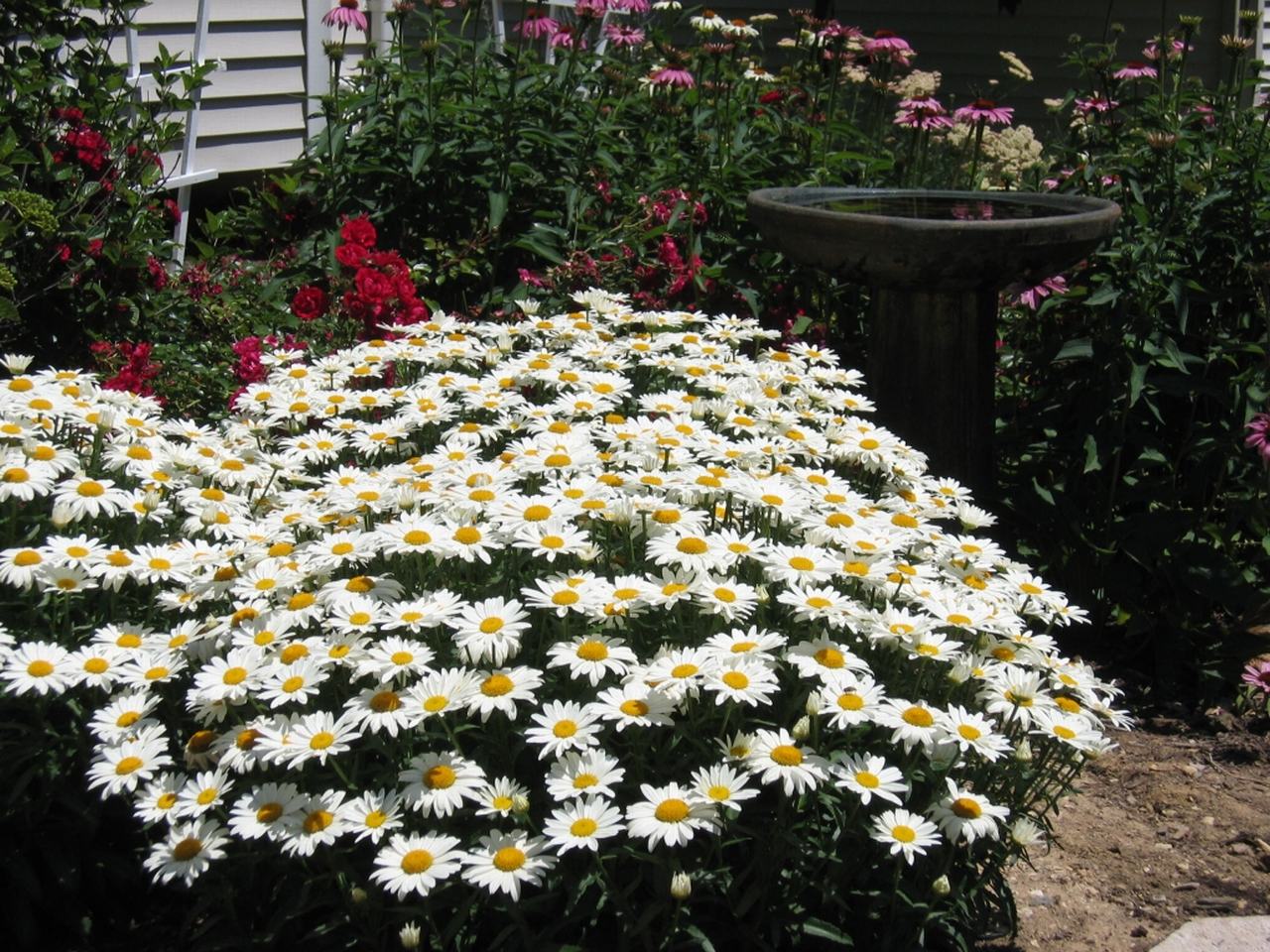
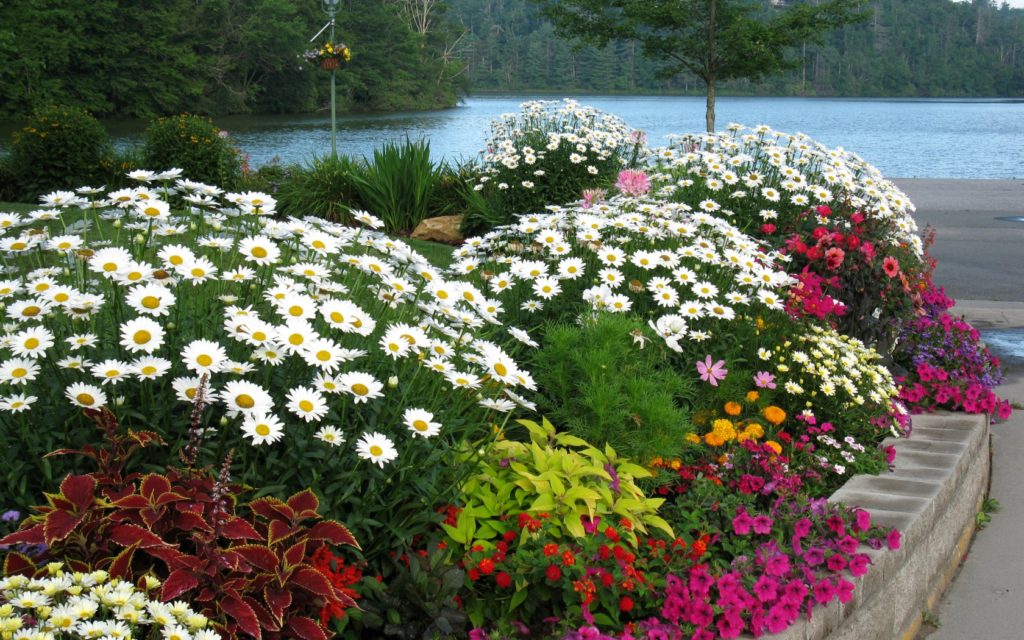
We hope that this article will help you grow a real highlight of your garden - garden chamomile. A little patience, effort and, of course, love of nature, and your dream to see a piece of chamomile field in your plot will surely come true. Successes in floriculture!
The usual daisy, which many people like to grow in their garden and summer cottage, is a real pleasure. Each of us at least once in his life wondered on this wonderful flower. But not only those who want to learn the secret of love, appreciate this beautiful plant.
Daisy-like flowers are a miracle in the garden.
Translated from the Latin word "romana" ("daisy") means "Roman". In the old daisy called "Romanov flower". In the forest, in the meadows and fields you can meet and her garden sister - in the gardens and cottages. In ancient times, people were completely confident that where the star fell, daisy blooms. And, for example, according to an ancient legend, this flower was an umbrella for forest tiny gnomes.
Nivyanik variety
Perennial white chamomile is grown on all garden plots, as it is distinguished by its freshness, reliability and decorative characteristics. This perennial with beautiful large flowers has a long and abundant flowering period. Tall, strong stems can reach a height of up to 1 meter, while the diameter of the flower itself can reach up to 15 cm. It is used for cultivation in group as well as single plantings along the paths and paths on the lawn.
In addition to the traditional species of "Nivyanik" - alpine and large-flowered - many other varieties have been developed with different colors and flower shapes.
Yellow flowers like daisy: yellow garden daisy
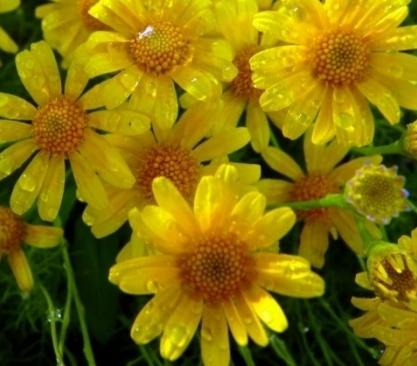
The main distinguishing feature of this variety is bright, but small in size flowers and openwork, carved leaves. Yellow daisy can feel great not only in the shade, but also in the sun, with and without watering, on poor and rich soil. It has a long flowering period: from the beginning of summer to the end of autumn. Yellow flower, like a chamomile, often grown in mixborders, in group, single plantings, along the paths, on lawns. And in any place it looks very attractive from an aesthetic point of view.
Chamomile-like flowers: planting conditions
It is best to plant these flowers in places sufficiently lit by the rays of the sun. In this case, the soil must be well fertilized and non-acidic. If at one place such a shrub is grown for a long time, then it thickens, as a result, tall stems become much thinner, and flowers become smaller.
 Breeding
Breeding
You can grow chamomile with the help of seeds. It should be planted on seedlings in March, and when several leaves appear, transplant into a separate pot. But the processes in the ground planted in May. Seeds can be planted directly into the ground at the end of May, after which it is necessary to cover with foil, and after 3 weeks you will be able to see the first shoots. Seedlings will begin to bloom in the second year. In addition, chamomile propagated by dividing the bush. This can be done once every 4 years and only in August. The bush is divided along with the ground part and the rhizome very carefully, so as not to damage root system. If you do this annually, the flowers will become very large.
Chamomile-like flowers: plant care
Care for this flower is a constant watering, weeding, thinning and loosening the soil. Every five years, it must be rejuvenated, so that the plant does not die. To do this, you need to separate part of the bush and plant it in another place. The resulting void must be filled with fertile soil. After three years, this process must be repeated. Garden chamomile well tolerated winter in middle lane in the open field, but if the winter is very cold and the flowers are not covered, they will die. Before the onset of winter, you need to trim the ground part of the chamomile to the very outlet of the sheet, thus you protect it from the cold.
Chamomile (Matricaria) is a genus of the Aster family, or Compositae (Asteraceae). The Russian name "chamomile" comes from the Latin "goshapa" - Roman. The Poles first called the plant "novels color."
In addition to matricaria, the common name “chamomile” is popularly called by its close relatives of the Astrovye family:,. However, there are many other beautiful garden plants with a similar “basket” flower. Complicated includes many genera, which by their appearance are very similar to chamomile, and the colors are the most diverse, from which they began to be called multi-colored daisies!
Anaciclus
Of all types of anaciclus (Anacyclus), only creeping (A.depressus), for rock garden, with pink flowers is usually grown. It is also called feverfew pressed. 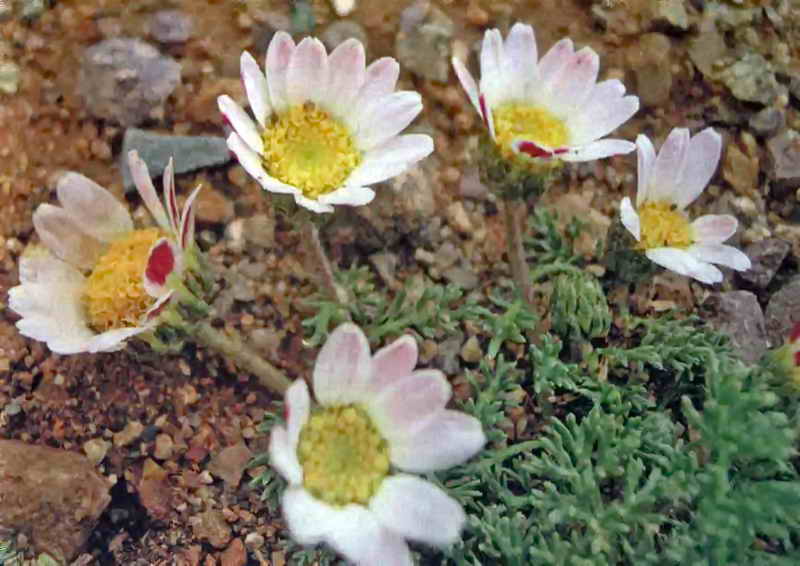
Before planting in a garden with heavy soil, this plant should definitely have a drainage bedding so that the water quickly leaves. By digging up a small trench, you can put coarse gravel or crushed stone, and light sandy soil on top. If the soil is sandy, the plant is planted on a hill without additional drainage.
When planting around you need to leave space for free growth of plant shoots. It happens that at some period the bush loses turgor and fades. Do not rush to throw away. It is quite possible that next season anaciklus will grow again. Often in the first years the plant very slowly gets used to the growing conditions. This usually happens when watering the landing site. But if he likes in your garden, he will be surprised by the unusual shape of the bush and the color of the flowers.
It blooms from May to July. For winter, anaciclus needs a good dry shelter (with a shelter film over a large layer of leaves). Shelter from moisture set in the fall, and insulated in October. In severe winters and winters with frequent thaws, the plant falls out; therefore, it is better to keep the “control” specimen of seedlings of the current year in a pot in a room with a temperature of about 0ºС; seeds are sown immediately after harvest. In good conditions, the plant can produce self-seeding.
Erigeron
This “daisy” is called the beautiful shallow glade, or Erigeron (Erigeron speciosus). It may well be its hybrid form, which has already appeared a lot. A beautiful richly flowering plant. Erigeron is planted in light partial shade, although it is well tolerated and the sun. Usually, the plant does not need additional shelter, but in the frosty winter, old bushes may fall out. The roots of all plants are better to mulch a layer of wood chips - this will help them to winter successfully.
The small-size painter adapts well to the conditions of the garden soil, only in too heavy soil during planting it is necessary to add sand. Otherwise, in such a wet area, the plant can get sick and die. With lush bushes and abundant flowering, the small-scale painter responds by adding a handful of ashes and one or two shovels of compost or leaf humus to the planting pit. The plant loves fertile soil, on which it quickly grows sockets, with which it is easiest to multiply it. Especially well basal rosettes are visible in the spring, which facilitates the division. Erigeron is usually planted in early spring or early autumn.
You can collect seeds and sow in March in a tank or in May-June in open ground. They usually sprout well. Erigeron is beautiful, and its varieties come with flowers of rich lilac, pale lilac, hot pink, pinkish-white and white.
Brahicom
The plant is very attractive. If you provide him with good conditions, during the flowering of brachicomes, leaves are not visible - so many flowers she reveals. However, despite the fact that there are perennial species of brachicomes, it is difficult to preserve them in winter, therefore in the middle belt it is grown from seeds as an annual plant.
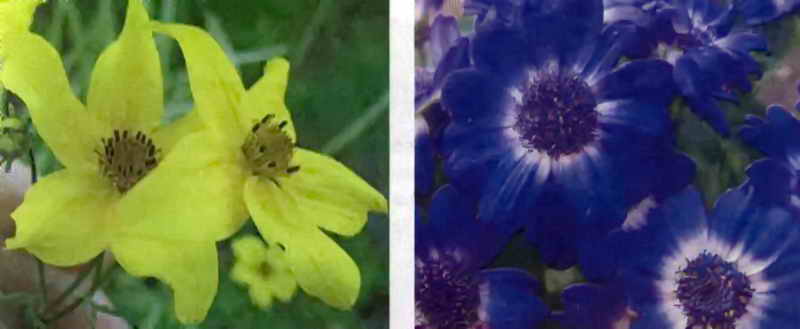 In order for the brachicome to bloom earlier, seeds must be sown in March in light soil. Then before planting in large garden containers beautiful lush bushes will have time to form. But this is if the seedlings to grow several times pinch.
In order for the brachicome to bloom earlier, seeds must be sown in March in light soil. Then before planting in large garden containers beautiful lush bushes will have time to form. But this is if the seedlings to grow several times pinch.
Especially beautiful brahikomu grow in hanging baskets with coconut felt, which make small holes - evenly over the entire surface, including the hemisphere. Then gently insert the root system of the seedlings along with a clod of earth into these holes. Begin to do this from the bottom, then planted side specimens. After that, the basket is filled up with nutrient loose and light soil (no dung!) And two or three plants are planted on top. Very soon, such a basket turns into a blooming ball. And if such balls are hung in the openings of a gazebo for a few - there is no more beautiful resting place than this! By the way, the same balls are obtained from one more “daisy” - the yellow-flowered series (Bidens). Only this plant should be pinched as often as possible during the entire vegetation period or processed from the very beginning of cultivation by retardants (growth retardants).
Coreopsis
This plant is often sold under the commercial names of yellow, red or blue chamomile. And in Latin, the flower is called Coreopsis - coreopsis. Moreover, the plants with yellow and pink (sometimes pomegranate) flowers - perennial, and with red, blue, crimson, purple - annuals.
 Annual Coreopsis popularly called "girl's eyes." Seeds can be sown on seedlings in early March, although they rather quickly (at the end of July) bloom even when sown in April immediately in open ground. With no less success, you can sow the seeds before winter. And if there is enough snow or at least a small mulch layer is poured from above, in the spring they will sprout safely. It will only remain to thin out the seedlings or spread more spaciously, i.e. make a pick.
Annual Coreopsis popularly called "girl's eyes." Seeds can be sown on seedlings in early March, although they rather quickly (at the end of July) bloom even when sown in April immediately in open ground. With no less success, you can sow the seeds before winter. And if there is enough snow or at least a small mulch layer is poured from above, in the spring they will sprout safely. It will only remain to thin out the seedlings or spread more spaciously, i.e. make a pick.
Plants are very unpretentious, but it is better to provide them with an open sunny place. Bushes actively give side shoots. Flowering will be abundant if the faded baskets are removed before frost. Two types of annual coreopsis are used in gardens: dyeing (C. tinctoria) and Drummond (S. drummondii). Both are attractive in flower beds, but different in height: dyeing in good conditions grows up to 90 cm, Drummond - up to 60 cm, but he also has handsome dwarfs 15-35 cm high.
Due to the drought resistance of coreopsis, low varieties are excellent for growing in pots and hanging pots, it is only important to take care that the soil is light and does not stagnate water. 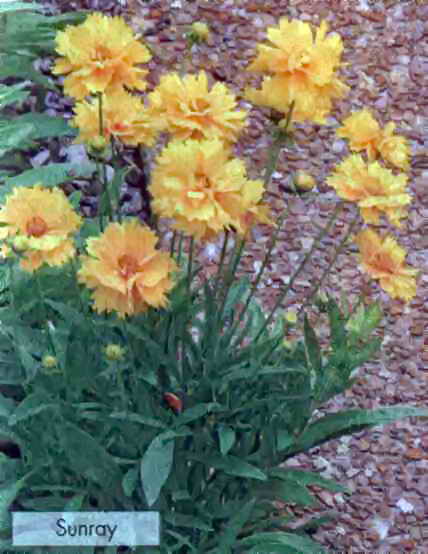
Perennial Coreopsis no less unpretentious, and once planted, four or five years, you can not take care of them.
Sow the seeds for seedlings or directly into the open ground, it is possible under the snow. Growing seedlings normal, no features not. It is only important not to fill in - coreopsis does not like excess moisture at any stage of development.
In the garden, choose a place with light sandy soil. If it is heavy, it can be safely mixed in half with sand or landed on an elevated spot, where excess water will quickly leave.
Even in the flowering state, the coriopsis easily tolerates the transplant, but at the same time it is necessary to preserve a little ground on the roots and water well after planting.
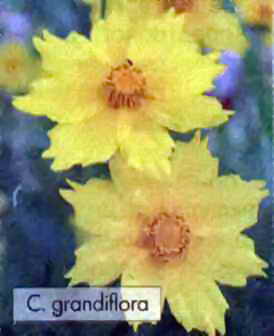 Perennial species have their own characteristics. For example, Coreopsis whorled and pink normally grow and bloom in partial shade, other species need open sun, otherwise the shoots are stretched and laid, and flowering becomes scarce.
Perennial species have their own characteristics. For example, Coreopsis whorled and pink normally grow and bloom in partial shade, other species need open sun, otherwise the shoots are stretched and laid, and flowering becomes scarce.


